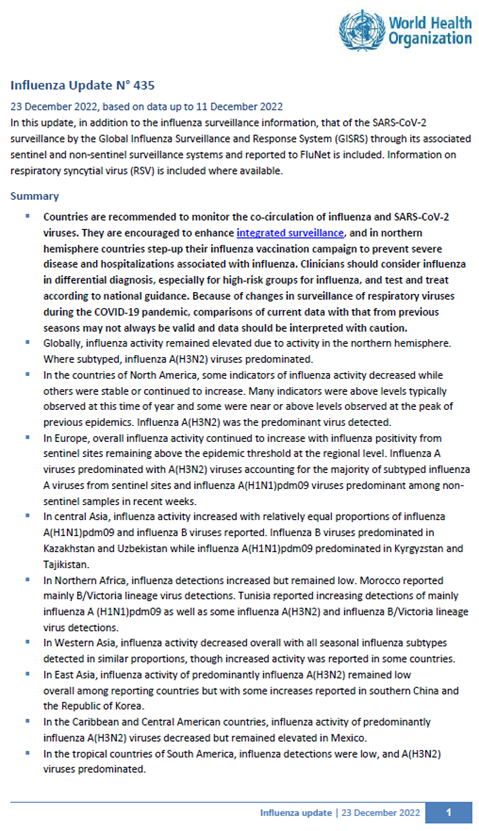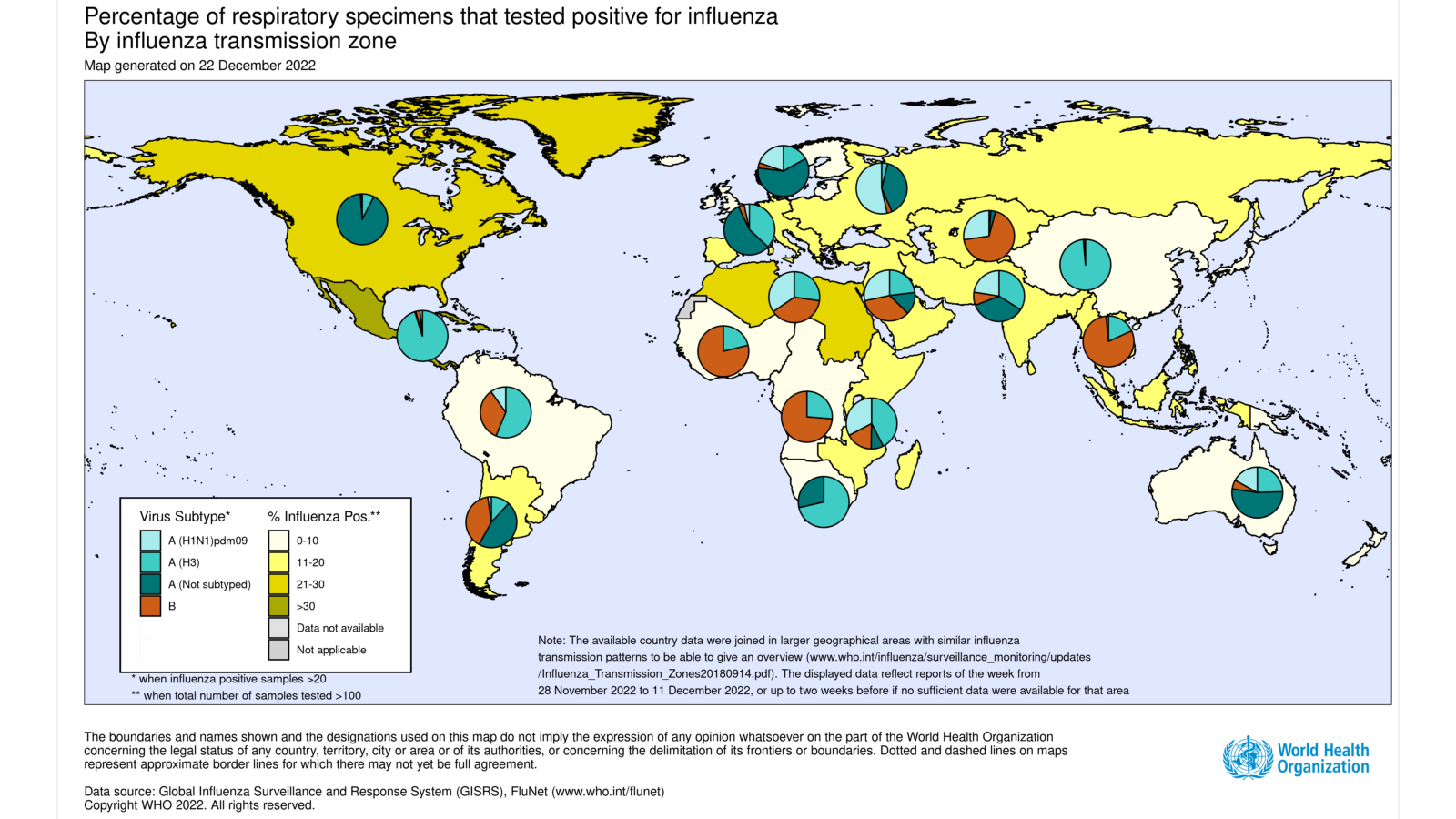Influenza Update N° 435

Overview
23 December 2022, based on data up to 11 December 2022
Information in this report is categorized by influenza transmission zones, which are geographical groups of countries, areas or territories with similar influenza transmission patterns. For more information on influenza transmission zones, see the link below:
Influenza Transmission Zones (pdf, 659kb)
- Countries are recommended to monitor the co-circulation of influenza and SARS-CoV-2 viruses. They are encouraged to enhance integrated surveillance and in northern hemisphere countries step-up their influenza vaccination campaign to prevent severe disease and hospitalizations associated with influenza. Clinicians should consider influenza in differential diagnosis, especially for high-risk groups for influenza, and test and treat according to national guidance. Because of changes in surveillance of respiratory viruses during the COVID-19 pandemic, comparisons of current data with that from previous seasons may not always be valid and data should be interpreted with caution.
- Globally, influenza activity remained elevated due to activity in the northern hemisphere. Where subtyped, influenza A(H3N2) viruses predominated.
- In the countries of North America, some indicators of influenza activity decreased while others were stable or continued to increase. Many indicators were above levels typically observed at this time of year and some were near or above levels observed at the peak of previous epidemics. Influenza A(H3N2) was the predominant virus detected.
- In Europe, overall influenza activity continued to increase with influenza positivity from sentinel sites remaining above the epidemic threshold at the regional level. Influenza A viruses predominated with A(H3N2) viruses accounting for the majority of subtyped influenza A viruses from sentinel sites and influenza A(H1N1)pdm09 viruses predominant among non-sentinel samples in recent weeks.
- In central Asia, influenza activity increased with relatively equal proportions of influenza A(H1N1)pdm09 and influenza B viruses reported. Influenza B viruses predominated in Kazakhstan and Uzbekistan while influenza A(H1N1)pdm09 predominated in Kyrgyzstan and Tajikistan.
- In Northern Africa, influenza detections increased but remained low. Morocco reported mainly B/Victoria lineage virus detections. Tunisia reported increasing detections of mainly influenza A (H1N1)pdm09 as well as some influenza A(H3N2) and influenza B/Victoria lineage virus detections.
- In Western Asia, influenza activity decreased overall with all seasonal influenza subtypes detected in similar proportions, though increased activity was reported in some countries.
- In East Asia, influenza activity of predominantly influenza A(H3N2) remained low overall among reporting countries but with some increases reported in southern China and the Republic of Korea.
- In the Caribbean and Central American countries, influenza activity of predominantly influenza A(H3N2) viruses decreased but remained elevated in Mexico.
- In the tropical countries of South America, influenza detections were low, and A(H3N2) viruses predominated.
- In tropical Africa, influenza activity remained low with detections of all seasonal influenza subtypes reported. An increased number of detections was reported from Eastern Africa.
- In Southern Asia, influenza activity continued to decrease to low levels, mainly due to decreased activity reported in Iran (Islamic Republic of). Influenza A(H1N1)pdm09 was the most frequently detected subtype in the subregion.
- In South-East Asia, detections of predominantly influenza B increased and remained elevated.
- In the temperate zones of the southern hemisphere, influenza activity decreased in Argentina and Chile and remained low elsewhere.
- National Influenza Centres (NICs) and other national influenza laboratories from 130 countries, areas or territories reported data to FluNet for the time period from 28 November 2022 to 11 December 2022 * (data as of 2022-12-22 15:49:17 UTC). The WHO GISRS laboratories tested more than 447 351 specimens during that time period. 81 619 were positive for influenza viruses, of which 79 209 (97%) were typed as influenza A and 2410 (3%) as influenza B. Of the sub-typed influenza A viruses, 4722 (28.6%) were influenza A(H1N1)pdm09 and 11 791 (71.4%) were influenza A(H3N2). Of the 370 characterized B viruses, all belonged to the B-Victoria lineage.

- COVID-19 positivity from sentinel surveillance continued to increase in the WHO Regions of the Americas (AMRO) and Western Pacific (WPRO). Activity increased to just over 25% in AMRO and to just below 10% in WPRO. Activity decreased across all other regions where activity remained under 10%. Globally, COVID-19 positivity from non-sentinel surveillance was around 10% or below except in AMRO and WPRO where activity maintained an increasing trend above 25%.
- During the COVID-19 pandemic, WHO encourages countries, especially those that have received the multiplex influenza and SARS-CoV-2 reagent kits from GISRS, to conduct integrated surveillance of influenza and SARS-CoV-2 and report epidemiological and laboratory information in a timely manner to established regional and global platforms. Revised interim guidance has just been published here: https://www.who.int/publications/i/item/WHO-2019-nCoV-integrated_sentinel_surveillance-2022.1.
- National Influenza Centres (NICs) and other national influenza laboratories from 78 countries, areas or territories from six WHO regions (African Region: 12; Region of the Americas: 18; Eastern Mediterranean Region: 6; European Region: 35; South-East Asia Region: 3; Western Pacific Region: 4) reported to FluNet from sentinel surveillance sites for time period from 28 Nov 2022 to 11 Dec 2022* (data as of 2022-12-22 15:49:16 UTC). The WHO GISRS laboratories tested more than 53 242 sentinel specimens during that time period and 7785 (14.6%) were positive for SARS-CoV-2. Additionally, more than 251 061 non-sentinel or undefined reporting source samples were tested in the same period and 68 119 were positive for SARS-CoV-2.
Source of data
______________________________________________________________________________________________
The Global Influenza Programme monitors influenza activity worldwide and publishes an update every two weeks. The updates are based on available epidemiological and virological data sources, including FluNet (reported by the WHO Global Influenza Surveillance and Response System), FluID (epidemiological data reported by national focal points) and influenza reports from WHO Regional Offices and Member States. Completeness can vary among updates due to availability and quality of data available at the time when the update is developed.
*It includes data only from countries reporting on positive and negative influenza specimens.
